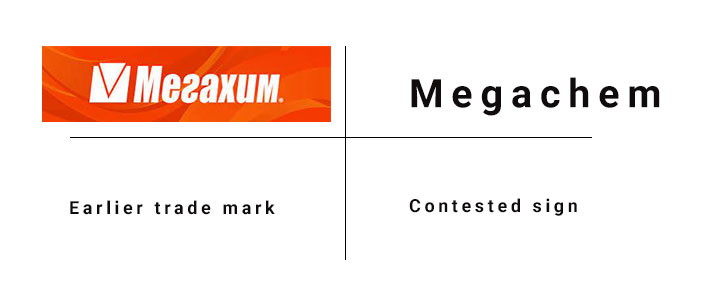 THE CASE
THE CASE
Megachim Ad,123 Lipnik Str., 7000 Ruse, Bulgaria (opponent), represented by Ip Consulting Ltd., 6-8, Mitropolit Kiril Vidinski Str., entr. 8, floor 2, office 2, 1164 Sofia, Bulgaria (professional representative) filed an opposition against Megachem Limited, 11 Tuas Link 1, 638588 Singapore, Singapore (applicant).
The goods and services
- The list of goods protected by the earlier mark reads as follows: Classes 1, 2.
- The contested goods and services are the following: 1, 35.
Contested goods in Class 1
The contested chemicals used in industry, none of these goods being used for the purposes of treating aluminium and aluminium alloys are contained in and, therefore, identical to the opponent’s broad category of chemicals used in industry.
The remaining goods in this class, as listed above, consist of a variety of chemical preparations. These goods are at least similar to the opponent’s chemicals used in industry as these goods coincide, at least, in their nature and manufacturers.
Contested services in Class 35
Retail services concerning the sale of specific goods are similar to an average degree to these specific goods. Although the nature, purpose and method of use of these goods and services are not the same, they are similar because they are complementary and the services are generally offered in the same places where the goods are offered for sale. Furthermore, they target the same public.
Therefore, the contested the bringing together, for the benefit of others, of a variety of chemicals, enabling customers to conveniently view and purchase those goods in a wholesale outlet or via the global communications network; none of the foregoing services being related to goods in the nature of formulated chemical products of metal chemistry or electro chemistry are similar to the opponent’s chemicals used in industry.
The contested procurement of contracts [for others] relating to the sale of goods are business mediation (intermediary) services rendered by specialists with the purpose of helping businesses to resolve their business-related problems, be it in the area of purchase, for example. Business mediation also includes services when a third party puts sellers and buyers of something in contact, negotiates between them and gets commission for such services. These services have no point of contact with the opponent’s chemicals in Class 1 and paints, varnishes and similar articles in Class 2. Apart from the fundamental differences between non- tangible services and tangible goods, the contested services and the opponent’s goods also differ in terms of the manufacturers/providers, distribution channels and customers, and they are neither complementary nor in competition. Therefore, these contested services are dissimilar to the opponent’s goods.
Relevant public — degree of attention
The average consumer of the category of products concerned is deemed to be reasonably well informed and reasonably observant and circumspect. It should also be borne in mind that the average consumer’s degree of attention is likely to vary according to the category of goods or services in question.
In the present case, the goods and services found to be identical or similar are directed essentially at professional consumers working in the chemicals industry.
The degree of attention is likely to be average to high, given the specialised nature of the goods and services and their potential impact on health and safety.
The signs

Visually, the signs coincide in the letter sequence ‘Me-a—M’ and differ in their remaining letters as well as in the earlier mark’s figurative elements. Given the importance of verbal elements over figurative ones and also the coincidence in the sign’s initial two letters, the Opposition Division considers that the signs are similar to a below average degree.
Aurally, the pronunciation of the signs coincides in the sound of the letters ‘Мега’/‛Mega-’ as well as in their last letter ‘-M’, and differ in that of their middle letters ‘-xи’ / ‘Che-’. It is recalled that consumers generally tend to focus on the beginning of a sign when they encounter a trade mark. This is because the public reads from left to right, which makes the part placed at the left of the sign (the initial part) the one that first catches the attention of the reader. Consequently, the signs’ coinciding initial four letters as well as their identical last letter make the signs similar to a high degree.
Conceptually, reference is made to the previous assertions concerning the semantic content conveyed by the marks. Both signs will be associated with the concepts of mega and chemical, therefore, the signs are conceptually identical to that extent. While these coinciding concepts are weak, at best, the signs lack any additional concept. Overall, the signs present a significant semantic overlap albeit this admittedly arises from concepts of low or non-distinctive character, therefore, there exists a certain degree of conceptual similarity between them.
CONCLUSION
European Union trade mark application No 10 319 028 is rejected for all the above goods and services. It may proceed for the remaining services.

